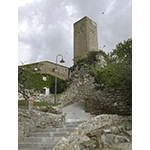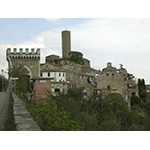Pereta Sulphur Mines
Among the most important of the entire grand-ducal territory, these sulphur mines were described by Repetti as: "About three miles from Pereta lies one of the richest sulphur pits of Tuscany. Quarried from deep shafts that communicate by means of tunnels, the material consists of clumps of sulphur mixed with various soils with the red iron oxide and, oftentimes with antimony sulphide (the crude antimony of the ancients). These excavations penetrate layers of calcareous and argillaceous rocks, both containing tenuous particles of sulphuric acid which decompose the calcareous and argillaceous rock to convert it into lime sulphate and aluminium sulphate. Near these sulphur pits lies an abandoned ferrous sulphate pit (green vitriol). These sulphur pits belong to the Royal Possessions and are usually hired out.
Contrary to what is documented for the nearby Zolfiere deposit, we have no certain news of exploitation of the Pereta mines in the Etruscan and Roman ages. Mining activities are instead well attested in the 18th and 19th centuries, and were in part destined to satisfy the international market. Transported up to the coast at Pietra Vergine on mules because of the poor road conditions, the mineral was loaded onto small sailing coasters which transported it to Livorno where it was sold on a large scale. The costs of transportation, along with the numerous accidents caused by collapses in the underground passages and by gas fumes (interesting in this regard are the accounts of eighteenth-century naturalist Giorgio Santi who reports the methods used to eliminate mofette from the tunnels) were the likely causes for suspending mining activities and adapting the buildings to farm use.
****************************
Texts by Elena Fani
English translation by Victor Beard
Last update 05/gen/2008





